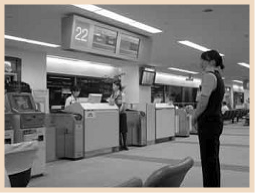
Todd Jay Leonard, Blog


Leave it to the Japanese to make traveling internationally and domestically as worry-free and easy as possible. I am always amazed at how effortless it is to travel by air in Japan nowadays.
Many services are available to air travelers that anticipate every imaginable need. For instance, Japan has an extraordinary delivery system that allows travelers to send big suitcases ahead to the airport.
Since most people travel to the airport by train or bus, this makes changing trains and getting to the airport much easier without worrying about bulky luggage that must be lugged up and down the stairways at train stations.
For a nominal sum, the delivery company will pick the luggage up at your home and deliver it to the terminal of the airport you are traveling from. This service is available all over Japan, and they can usually guarantee 24-hour delivery to the airport. The process is reversed when returning, allowing travelers to send their luggage from the airport to their homes.
The company I use regularly wraps my suitcase in plastic and gingerly handles it throughout the delivery process. Rarely is any piece of luggage damaged during delivery in Japan. These companies are called "takubin" and will deliver just about anything, anywhere in Japan.
I can order a turkey in Tokyo and have it delivered still frozen to my door in a day. Fragile items are regularly handled with care without as much as a scratch on the box when it is delivered. This care and concern for packages has me spoiled.
Recently I sent a ceramic bowl ensconced in bubble-wrap by airmail to the United States. I know it was treated properly on this end. However, when it arrived at its destination it was in a million pieces.
Naively, I put a "fragile" sticker on it. When I told a friend whose brother is a mail carrier for the U.S. Postal Service about this, she laughed. She said her brother advised her to check a package by throwing it out her front door onto the asphalt. If it doesn't break, then it is wrapped properly. The huge volume of packages that go through the U.S. Postal Service requires that they be chucked from bin to bin before being delivered. A hard lesson learned.
However, I digress, so back to air travel in Japan ...
Since many people don't have cars, and those who do opt not to drive them to the airport, there are a number of private and public transportation options available.
Personally, I usually take a "jumbo taxi" from my home to the prefectural airport. It takes about an hour and is quite reasonable in price. There also is a city bus that goes to the airport several times a day.
Even though Japan is roughly the size of California, it is much more difficult to travel domestically from north to south. Flights from Aomori to Tokyo take an hour; but by highway bus it takes nine hours; by bullet train around five hours; and by overnight sleeper-train about 10 hours.
The bullet train isn't too bad, but where I live I have to change trains at least once to get to Tokyo. Within the next decade, there should be a bullet train from Aomori City, which will be more convenient, but for the time being I usually fly to save in travel time.
It never fails that when I am waiting for a flight, airline staff are scurrying about trying to find wayward passengers at the largest domestic airport in Japan, Haneda-Tokyo.
With walkie-talkies in hand, they are rushing from the security inspection area to the gate, yelling out individual passengers' names, trying to alert them that their flight is about to leave.
When they locate the passenger, the airline staff people will often help carry the luggage the person has with them to the gate. Bowing and running at the same time.
This would rarely (if ever) happen at Chicago O'Hare or even Indianapolis International. If you aren't there when the cabin door closes, you are out of luck. There are no extraordinary efforts made to find confirmed passengers who haven't passed through the gateway.
Japanese airline personnel are well-known for their politeness and neatness in appearance. Flight attendants are so well-trained that they flawlessly perform their duties exactly the same way every time. It is refreshing to be treated nicely as well. When they speak to you, they kneel down to be face to face. They use very polite language, as well as gesturing graciously to assist you with the light, headphones, etc.
This is quite a departure from U.S. carriers' treatment of passengers, where the flight attendants, standing above you - obviously irritated at being disturbed - bark out "Chicken or beef?" in a nasty tone of voice.
Yes, I am spoiled at the wonderful service Japanese companies offer their customers. ... U.S. airlines and related industries could certainly learn a thing or two from their Japanese counterparts.
Politeness would be a good place to start.
By TODD JAY LEONARD
Columnist
Friendly skies
Compared to Japan, air travel in the United States is for the birds
Monday, October 9 , 2006







